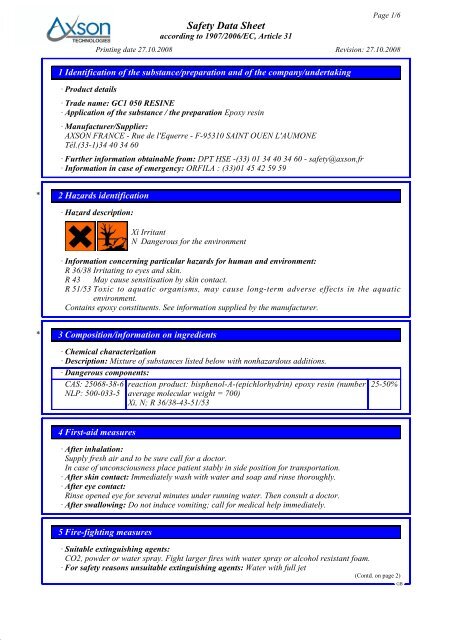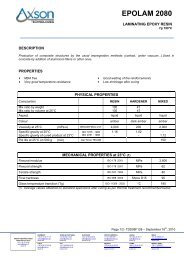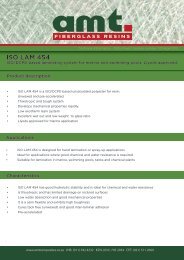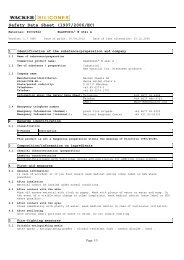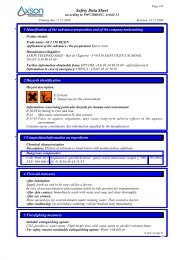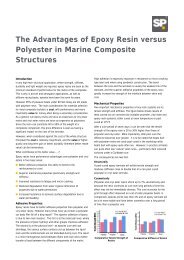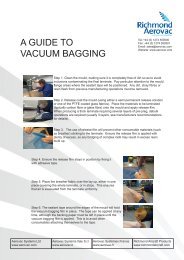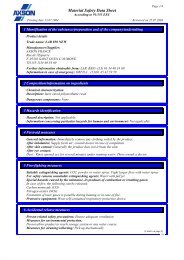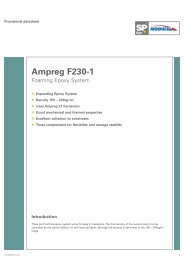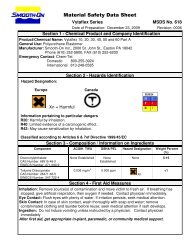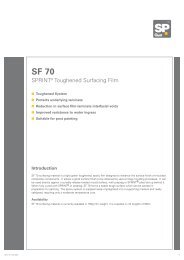Safety Data Sheet - AMT Composites
Safety Data Sheet - AMT Composites
Safety Data Sheet - AMT Composites
- No tags were found...
You also want an ePaper? Increase the reach of your titles
YUMPU automatically turns print PDFs into web optimized ePapers that Google loves.
DR<strong>Safety</strong> <strong>Data</strong> <strong>Sheet</strong>according to 1907/2006/EC, Article 31Page 1/6Printing date 27.10.2008 Revision: 27.10.20081 Identification of the substance/preparation and of the company/undertaking· Product details· Trade name: GC1 050 RESINE· Application of the substance / the preparation Epoxy resin· Manufacturer/Supplier:AXSON FRANCE - Rue de l'Equerre - F-95310 SAINT OUEN L'AUMONETél.(33-1)34 40 34 60· Further information obtainable from: DPT HSE -(33) 01 34 40 34 60 - safety@axson.fr· Information in case of emergency: ORFILA : (33)01 45 42 59 59* 2 Hazards identification· Hazard description:Xi IrritantN Dangerous for the environment· Information concerning particular hazards for human and environment:R 36/38 Irritating to eyes and skin.R 43 May cause sensitisation by skin contact.R 51/53 Toxic to aquatic organisms, may cause long-term adverse effects in the aquaticenvironment.Contains epoxy constituents. See information supplied by the manufacturer.* 3 Composition/information on ingredients· Chemical characterization· Description: Mixture of substances listed below with nonhazardous additions.· Dangerous components:CAS: 25068-38-6NLP: 500-033-5reaction product: bisphenol-A-(epichlorhydrin) epoxy resin (numberaverage molecular weight = 700)Xi, N; R 36/38-43-51/5325-50%4 First-aid measures· After inhalation:Supply fresh air and to be sure call for a doctor.In case of unconsciousness place patient stably in side position for transportation.· After skin contact: Immediately wash with water and soap and rinse thoroughly.· After eye contact:Rinse opened eye for several minutes under running water. Then consult a doctor.· After swallowing: Do not induce vomiting; call for medical help immediately.5 Fire-fighting measures· Suitable extinguishing agents:CO2, powder or water spray. Fight larger fires with water spray or alcohol resistant foam.· For safety reasons unsuitable extinguishing agents: Water with full jet(Contd. on page 2)GB
DR<strong>Safety</strong> <strong>Data</strong> <strong>Sheet</strong>according to 1907/2006/EC, Article 31Page 2/6Printing date 27.10.2008 Revision: 27.10.2008Trade name: GC1 050 RESINE(Contd. of page 1)· Special hazards caused by the substance, its products of combustion or resulting gases:In case of fire, the following can be released:Carbon monoxide (CO)Under certain fire conditions, traces of other toxic gases cannot be excluded, e.g.:Hydrogen chloride (HCl)· Protective equipment:Wear fully protective suit.Wear self-contained respiratory protective device.· Additional informationCollect contaminated fire fighting water separately. It must not enter the sewage system.Dispose of fire debris and contaminated fire fighting water in accordance with official regulations.6 Accidental release measures· Person-related safety precautions: Wear protective equipment. Keep unprotected persons away.· Measures for environmental protection: Do not allow to enter sewers/ surface or ground water.· Measures for cleaning/collecting:Absorb with liquid-binding material (sand, diatomite, acid binders, universal binders, sawdust).7 Handling and storage· Handling:· Information for safe handling: Ensure good ventilation/exhaustion at the workplace.· Information about fire - and explosion protection: No special measures required.· Storage:· Requirements to be met by storerooms and receptacles: Prevent any seepage into the ground.· Information about storage in one common storage facility: Store away from foodstuffs.· Further information about storage conditions:Store in cool, dry conditions in well sealed receptacles.8 Exposure controls/personal protection· Additional information about design of technical facilities: No further data; see item 7.· Ingredients with limit values that require monitoring at the workplace:The product does not contain any relevant quantities of materials with critical values that have tobe monitored at the workplace.· Personal protective equipment:· General protective and hygienic measures:The usual precautionary measures are to be adhered to when handling chemicals.Immediately remove all soiled and contaminated clothingWash hands before breaks and at the end of work.Avoid contact with the eyes and skin.· Respiratory protection: Not necessary if room is well-ventilated.· Protection of hands:Protective gloves· Material of glovesSynthetic rubber glovesThe selection of the suitable gloves does not only depend on the material, but also on further marksof quality and varies from manufacturer to manufacturer. As the product is a preparation of several(Contd. on page 3)GB
DR<strong>Safety</strong> <strong>Data</strong> <strong>Sheet</strong>according to 1907/2006/EC, Article 31Page 3/6Printing date 27.10.2008 Revision: 27.10.2008Trade name: GC1 050 RESINE(Contd. of page 2)substances, the resistance of the glove material can not be calculated in advance and has thereforeto be checked prior to the application.· Penetration time of glove materialThe exact break trough time has to be found out by the manufacturer of the protective gloves andhas to be observed.· Eye protection:<strong>Safety</strong> glassesTightly sealed goggles· Body protection: Protective work clothing9 Physical and chemical properties· General InformationForm:Highly viscousColour:Various coloursOdour:Weak, characteristic· Change in conditionMelting point/Melting range: NA°CBoiling point/Boiling range: >200°C (DIN 53171)· Flash point: >110°C (ISO 2719)· Ignition temperature: >300°C (DIN 51 794)· Decomposition temperature: >200°C (DIN 53171)· Self-igniting: Product is not selfigniting.· Danger of explosion: Product does not present an explosion hazard.· Density at 25°C: 1.57 g/cm³· Solubility in / Miscibility withwater:Insoluble.· organic solvents: Soluble in many organic solvents.10 Stability and reactivity· Thermal decomposition / conditions to be avoided:No decomposition if used according to specifications.· Dangerous reactionsMay produce violent reactions with bases and numerous organic substances including alcohols andamines.Exothermic polymerization.· Dangerous decomposition products: Irritant gases/vapoursGB(Contd. on page 4)
DR<strong>Safety</strong> <strong>Data</strong> <strong>Sheet</strong>according to 1907/2006/EC, Article 31Page 4/6Printing date 27.10.2008 Revision: 27.10.2008Trade name: GC1 050 RESINE(Contd. of page 3)11 Toxicological information· Acute toxicity:· LD/LC50 values relevant for classification:25068-38-6 reaction product: bisphenol-A-(epichlorhydrin) epoxy resin (number averagemolecular weight = 700)Oral LD50 11400 mg/kg (rat)Dermal LD50 >2000 mg/kg (rabbit)· Primary irritant effect:· on the skin: Irritant to skin and mucous membranes.· on the eye: Irritating effect.· Sensitisation May cause sensitisation by skin contact.12 Ecological information· Information about elimination (persistence and degradability):· Other information: The product is difficultly biodegradable.· General notes: At present there are no ecotoxicological assessments.13 Disposal considerations· Product:· RecommendationMust not be disposed together with household garbage. Do not allow product to reach sewagesystem.Dispose of the product by burning in a suitable incinerator or bury in an approved landfieldfollowing all applicable local and/or national regulations.· European waste catalogue20 01 27 paint, inks, adhesives and resins containing dangerous substances· Uncleaned packaging:· Recommendation:Empty containers may not be disposed of unless any remaining material adhering to the internalwalls has been removed.Disposal must be made according to official regulations.14 Transport information· Land transport ADR/RID (cross-border)· ADR/RID class: 9 Miscellaneous dangerous substances and articles.· Danger code (Kemler): 90· UN-Number: 3082· Packaging group: III· Hazard label 9(Contd. on page 5)GB
DR<strong>Safety</strong> <strong>Data</strong> <strong>Sheet</strong>according to 1907/2006/EC, Article 31Page 5/6Printing date 27.10.2008 Revision: 27.10.2008Trade name: GC1 050 RESINE(Contd. of page 4)· Description of goods: 3082 ENVIRONMENTALLY HAZARDOUS SUBSTANCE, LIQUID, N.O.S.(epoxy resins)· Maritime transport IMDG:· IMDG Class: 9· UN Number: 3082· Label 9· Packaging group: III· Marine pollutant: No· Proper shipping name: ENVIRONMENTALLY HAZARDOUS SUBSTANCE, LIQUID, N.O.S.(epoxy resins)· Air transport ICAO-TI and IATA-DGR:· ICAO/IATA Class: 9· UN/ID Number: 3082· Label 9· Packaging group: III· Proper shipping name: ENVIRONMENTALLY HAZARDOUS SUBSTANCE, LIQUID, N.O.S.(epoxy resins)* 15 Regulatory information· Labelling according to EU guidelines:The product has been marked in accordance with EU Directives / respective national laws.· Code letter and hazard designation of product:Xi IrritantN Dangerous for the environment· Hazard-determining components of labelling:reaction product: bisphenol-A-(epichlorhydrin) epoxy resin (number average molecular weight =700)· Risk phrases:36/38 Irritating to eyes and skin.43 May cause sensitisation by skin contact.51/53 Toxic to aquatic organisms, may cause long-term adverse effects in the aquatic environment.· <strong>Safety</strong> phrases:3 Keep in a cool place.23 Do not breathe gas/fumes/vapour/spray.24 Avoid contact with skin.26 In case of contact with eyes, rinse immediately with plenty of water and seek medical advice.37/39 Wear suitable gloves and eye/face protection.57 Use appropriate container to avoid environmental contamination.· Special labelling of certain preparations:Contains epoxy constituents. See information supplied by the manufacturer.(Contd. on page 6)GB
DR<strong>Safety</strong> <strong>Data</strong> <strong>Sheet</strong>according to 1907/2006/EC, Article 31Page 6/6Printing date 27.10.2008 Revision: 27.10.2008Trade name: GC1 050 RESINE· National regulations:· Waterhazard class: Water hazard class 2 (Self-assessment): hazardous for water.(Contd. of page 5)16 Other informationThis information is based on our present knowledge. However, this shall not constitute a guaranteefor any specific product features and shall not establish a legally valid contractual relationship.· Relevant R-phrases36/38 Irritating to eyes and skin.43 May cause sensitisation by skin contact.51/53 Toxic to aquatic organisms, may cause long-term adverse effects in the aquatic environment.GB
DR<strong>Safety</strong> <strong>Data</strong> <strong>Sheet</strong>according to 1907/2006/EC, Article 31Page 1/6Printing date 19.03.2009 Revision: 17.03.20091 Identification of the substance/preparation and of the company/undertaking· Product details· Trade name: GC 10 DURCISSEUR· Application of the substance / the preparation Epoxy curing agent· Manufacturer/Supplier:AXSON TECHNOLOGIES - Rue de l'Equerre - F-95310 SAINT OUEN L'AUMONETél.(33-1)34 40 34 60· Further information obtainable from: DPT HSE -(33) 01 34 40 34 60 - safety@axson.fr· Information in case of emergency: ORFILA : (33)01 45 42 59 59* 2 Hazards identification· Hazard description:C CorrosiveN Dangerous for the environment· Information concerning particular hazards for human and environment:R 21/22 Harmful in contact with skin and if swallowed.R 34 Causes burns.R 37 Irritating to respiratory system.R 43 May cause sensitisation by skin contact.R 62 Possible risk of impaired fertility.R 51/53 Toxic to aquatic organisms, may cause long-term adverse effects in the aquaticenvironment.* 3 Composition/information on ingredients· Chemical characterization· Description: Mixture of substances listed below with nonhazardous additions.· Dangerous components:CAS: 80-05-7EINECS: 201-245-8CAS: 90640-66-7EINECS: 292-587-7CAS: 111-40-0EINECS: 203-865-4bisphenol AXn, Xi; R 37-41-43-62Polyethylenpolyamines, tetraethylenepentamineC, Xn, N; R 21/22-34-43-51/532,2'-iminodiethylamineC, Xn; R 21/22-34-4325-50%25-50%10-25%4 First-aid measures· General information: Immediately remove any clothing soiled by the product.· After inhalation:Supply fresh air; consult doctor in case of complaints.In case of unconsciousness place patient stably in side position for transportation.· After skin contact:Immediately wash with water and soap and rinse thoroughly.If skin irritation continues, consult a doctor.· After eye contact:Rinse opened eye for several minutes under running water. Then consult a doctor.(Contd. on page 2)GB
DR<strong>Safety</strong> <strong>Data</strong> <strong>Sheet</strong>according to 1907/2006/EC, Article 31Page 2/6Printing date 19.03.2009 Revision: 17.03.2009Trade name: GC 10 DURCISSEUR· After swallowing: Do not induce vomiting; call for medical help immediately.(Contd. of page 1)5 Fire-fighting measures· Suitable extinguishing agents:CO2, powder or water spray. Fight larger fires with water spray or alcohol resistant foam.· For safety reasons unsuitable extinguishing agents: Water with full jet· Special hazards caused by the substance, its products of combustion or resulting gases:In case of fire, the following can be released:Nitrogen oxides (NOx)Carbon monoxide (CO)· Protective equipment:Wear self-contained respiratory protective device.Wear fully protective suit.· Additional informationCollect contaminated fire fighting water separately. It must not enter the sewage system.Dispose of fire debris and contaminated fire fighting water in accordance with official regulations.6 Accidental release measures· Person-related safety precautions: Wear protective equipment. Keep unprotected persons away.· Measures for environmental protection: Do not allow to enter sewers/ surface or ground water.· Measures for cleaning/collecting:Absorb with liquid-binding material (sand, diatomite, acid binders, universal binders, sawdust).Dispose contaminated material as waste according to item 13.Ensure adequate ventilation.7 Handling and storage· Handling:· Information for safe handling:Ensure good ventilation/exhaustion at the workplace.Open and handle receptacle with care.· Information about fire - and explosion protection: Protect from heat.· Storage:· Requirements to be met by storerooms and receptacles: Prevent any seepage into the ground.· Information about storage in one common storage facility: Store away from foodstuffs.· Further information about storage conditions:Store in cool, dry conditions in well sealed receptacles.8 Exposure controls/personal protection· Additional information about design of technical facilities: No further data; see item 7.· Ingredients with limit values that require monitoring at the workplace:111-40-0 2,2'-iminodiethylamineOES Long-term value: 4.3 mg/m³, 1 ppmSk· Additional information: The lists valid during the making were used as basis.(Contd. on page 3)GB
DR<strong>Safety</strong> <strong>Data</strong> <strong>Sheet</strong>according to 1907/2006/EC, Article 31Page 3/6Printing date 19.03.2009 Revision: 17.03.2009Trade name: GC 10 DURCISSEUR· Personal protective equipment:· General protective and hygienic measures:The usual precautionary measures are to be adhered to when handling chemicals.Immediately remove all soiled and contaminated clothingWash hands before breaks and at the end of work.Avoid contact with the eyes and skin.· Respiratory protection: Not necessary if room is well-ventilated.· Protection of hands:(Contd. of page 2)Protective gloves· Material of glovesNeoprene glovesThe selection of the suitable gloves does not only depend on the material, but also on further marksof quality and varies from manufacturer to manufacturer. As the product is a preparation ofseveral substances, the resistance of the glove material can not be calculated in advance and hastherefore to be checked prior to the application.· Penetration time of glove materialThe exact break trough time has to be found out by the manufacturer of the protective gloves andhas to be observed.· Eye protection:<strong>Safety</strong> glassesTightly sealed goggles· Body protection: Protective work clothing9 Physical and chemical properties· General InformationForm:Colour:Odour:FluidAmber colouredAmine-like· Change in conditionMelting point/Melting range: NA°CBoiling point/Boiling range: >200°C (DIN 53171)· Flash point: > 100°C (ISO 2719)· Ignition temperature: >300°C (DIN 51 794)· Decomposition temperature: >260°C (DIN 53171)· Self-igniting: Product is not selfigniting.· Danger of explosion: Product does not present an explosion hazard.· Density at 20°C: 0.98 g/cm³ (ISO 1675:1985)· Solubility in / Miscibility withwater:Not miscible or difficult to mix.· organic solvents: Soluble in many organic solvents.(Contd. on page 4)GB
DR<strong>Safety</strong> <strong>Data</strong> <strong>Sheet</strong>according to 1907/2006/EC, Article 31Page 4/6Printing date 19.03.2009 Revision: 17.03.2009Trade name: GC 10 DURCISSEUR· pH-value at 20°C: >10(Contd. of page 3)10 Stability and reactivity· Thermal decomposition / conditions to be avoided:No decomposition if used according to specifications.· Dangerous reactions Strong exothermic reaction with acids.· Dangerous decomposition products:Corrosive gases/vapoursAmmonia11 Toxicological information· Acute toxicity:· LD/LC50 values relevant for classification:111-40-0 2,2'-iminodiethylamineOral LD50 1080 mg/kg (rat)Dermal LD50 1090 mg/kg (rabbit)· Primary irritant effect:· on the skin: Caustic effect on skin and mucous membranes.· on the eye: Strong caustic effect.· Additional toxicological information:Swallowing will lead to a strong caustic effect on mouth and throat and to the danger ofperforation of esophagus and stomach.· Sensitisation May cause sensitisation by skin contact.12 Ecological information· Information about elimination (persistence and degradability):· Other information: The product is difficultly biodegradable.· General notes: At present there are no ecotoxicological assessments.13 Disposal considerations· Product:· RecommendationDispose of the product by burning in a suitable incinerator or bury in an approved landfieldfollowing all applicable local and/or national regulations.· European waste catalogue20 01 27 paint, inks, adhesives and resins containing dangerous substances· Uncleaned packaging:· Recommendation:Empty containers may not be disposed of unless any remaining material adhering to the internalwalls has been removed.Disposal must be made according to official regulations.· Recommended cleansing agents: Water, if necessary together with cleansing agents.GB(Contd. on page 5)
DR<strong>Safety</strong> <strong>Data</strong> <strong>Sheet</strong>according to 1907/2006/EC, Article 31Page 5/6Printing date 19.03.2009 Revision: 17.03.2009Trade name: GC 10 DURCISSEUR(Contd. of page 4)14 Transport information· Land transport ADR/RID (cross-border)· ADR/RID class: 8 Corrosive substances.· Danger code (Kemler): 80· UN-Number: 1760· Packaging group: III· Hazard label 8· Description of goods: 1760 CORROSIVE LIQUID, N.O.S. (Tetraethylenepentamine)· Maritime transport IMDG:· IMDG Class: 8· UN Number: 1760· Label 8· Packaging group: III· EMS Number: F-A,S-B· Marine pollutant: No· Proper shipping name: CORROSIVE LIQUID, N.O.S. (Tetraethylenepentamine)· Air transport ICAO-TI and IATA-DGR:· ICAO/IATA Class: 8· UN/ID Number: 1760· Label 8· Packaging group: III· Proper shipping name: CORROSIVE LIQUID, N.O.S. (Tetraethylenepentamine)15 Regulatory information· Labelling according to EU guidelines:The product has been marked in accordance with EU Directives / respective national laws.· Code letter and hazard designation of product:C CorrosiveN Dangerous for the environment· Hazard-determining components of labelling:Polyethylenpolyamines, tetraethylenepentaminebisphenol A2,2'-iminodiethylamine· Risk phrases:21/22 Harmful in contact with skin and if swallowed.34 Causes burns.37 Irritating to respiratory system.(Contd. on page 6)GB
DR<strong>Safety</strong> <strong>Data</strong> <strong>Sheet</strong>according to 1907/2006/EC, Article 31Page 6/6Printing date 19.03.2009 Revision: 17.03.2009Trade name: GC 10 DURCISSEUR(Contd. of page 5)43 May cause sensitisation by skin contact.62 Possible risk of impaired fertility.51/53 Toxic to aquatic organisms, may cause long-term adverse effects in the aquatic environment.· <strong>Safety</strong> phrases:20 When using do not eat or drink.23 Do not breathe gas/fumes/vapour/spray.26 In case of contact with eyes, rinse immediately with plenty of water and seek medicaladvice.36/37/39 Wear suitable protective clothing, gloves and eye/face protection.45 In case of accident or if you feel unwell, seek medical advice immediately (show the labelwhere possible).57 Use appropriate container to avoid environmental contamination.· National regulations:· Waterhazard class: Water hazard class 2 (Self-assessment): hazardous for water.16 Other informationThis information is based on our present knowledge. However, this shall not constitute a guaranteefor any specific product features and shall not establish a legally valid contractual relationship.· Relevant R-phrases21/22 Harmful in contact with skin and if swallowed.34 Causes burns.37 Irritating to respiratory system.41 Risk of serious damage to eyes.43 May cause sensitisation by skin contact.51/53 Toxic to aquatic organisms, may cause long-term adverse effects in the aquatic environment.62 Possible risk of impaired fertility.GB


